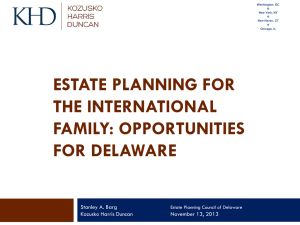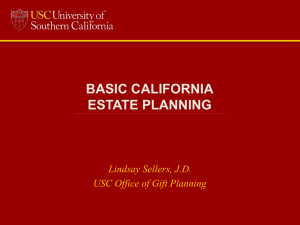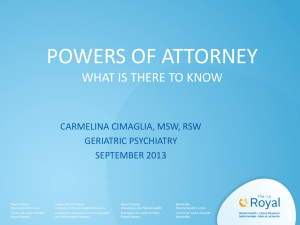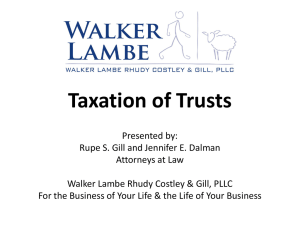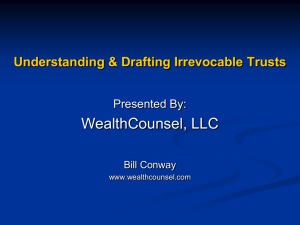Grantor - Giarmarco, Mullins & Horton, PC
advertisement
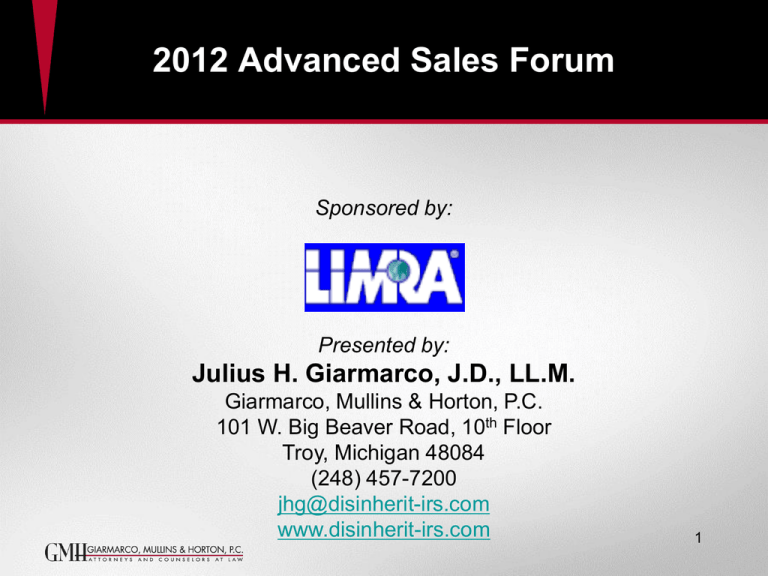
2012 Advanced Sales Forum Sponsored by: Presented by: Julius H. Giarmarco, J.D., LL.M. Giarmarco, Mullins & Horton, P.C. 101 W. Big Beaver Road, 10th Floor Troy, Michigan 48084 (248) 457-7200 jhg@disinherit-irs.com www.disinherit-irs.com 1 Estate, Gift, and GST Taxes Basis Method GST Tax Exemption Top Estate/GST Tax Rate Gift Tax Exemption Top Gift Tax Rate $3,500,000 Step-up in basis $3,500,000 45% $1,000,000 45% -0- Modified carryover basis -0- 0% $5,000,000 Step-up in basis $5,000,000 35% $1,000,000 35% 20112 $5,000,000 Step-up in basis $5,000,000 35% $5,000,000 35% 20123 $5,120,000 Step-up in basis $5,120,000 35% $5,120,000 35% 2013 $1,000,000 Step-up in basis $1,000,0004 55% $1,000,000 55% Year 2009 20101 Estate Tax Exemption 1 The Tax Relief Act of 2010: • For individuals who died in 2010: Tax the decedent’s assets at 35%, after estate tax exemption of $5 million and receive a “stepped up” income tax basis equal to fair market value at death. Alternatively, elect out of the estate tax regime, no estate tax is assessed and modified carryover basis rules apply in determining recipients’ income tax basis in the assets. 2 For 2011 and 2012, portability of the estate tax exemption between married couples (Note: Not applicable to GST tax exemption). 3 Estate, GST, and gift tax exemptions are indexed for inflation in 2012. 4 Indexed for inflation ($1.4M estimate). 2 Wealth Transfer Strategies Over Lifetime Annually Transfer of wealth excluded from any gift tax • $13,000 per individual ($26,000 gift splitting with spouse) per donee • Direct payments to educational institutions and health care providers1 Transfer of wealth through GST, estate, and gift tax exemptions Transfer of wealth utilizing discount strategies Transfer of wealth utilizing freeze strategies (appreciation-only gifts) • Gift tax exemption of up to $5M per individual • Family limited partnership (FLP) • Grantor retained annuity trust (GRAT) • GST and estate tax exemptions of $5M per individual3 • Family limited liability company (FLLC) • Intentionally defective grantor trust (IDGT) • Non-voting shares in family corporation (C or S corporation) • Qualified personal residence trust (QPRT) • Generation-skipping transfer trust (GST) • Irrevocable life insurance trusts (ILIT)2 Transfer of wealth through taxable gifts • Pay gift tax now rather than paying estate tax later • Converting traditional IRA to Roth IRA5 • Intra-family loan • Statutory freeze partnership (FLP or FLLC)4 Charitable planning: CRTs and CLTs. 1 To qualify for exclusion, gifts of tuition and medical expenses must be made directly to the provider. Often can be structured to use annual exclusion gifting. 3 In 2012, an estate is taxed at a top rate of 35% with a $5.12 million estate tax exemption and a $5.12 million GST tax exemption. 4 Can serve to both utilize discount and transfer wealth utilizing freeze strategies. 5 Paying the income tax in converting a traditional IRA to a Roth IRA is essentially a tax-free gift. 2 3 2012: A Perfect Storm for Gifting Low property values. Historically low AFRs and Section 7520 rates. $5.12M gift/GST tax exemptions are expiring. President Obama’s proposals are looming. 4 President Obama’s 2013 Budget Proposal Reduce the estate and GST exemptions to $3.5 million and the gift tax exemption to $1 million and provide a top rate of 45% for those taxes. Portability of a deceased spouse’s unused estate and gift tax exemption would continue. 5 President Obama’s 2013 Budget Proposal Eliminate a trust’s GST exemption on the trust’s 90th anniversary. Eliminate valuation discounts on familycontrolled entities. Require a minimum 10-year term for GRATs. 6 President Obama’s 2013 Budget Proposal Modify the treatment of “grantor trusts” so that: Trust assets would be subject to estate tax. Distributions to a beneficiary during the grantor’s lifetime would be subject to a gift tax. Trust assets would be subject to gift tax if the trust ceases to be a grantor trust during the grantor’s lifetime. 7 President Obama’s 2013 Budget Proposal Caution: Most ILITs are grantor trusts! The power to use trust income to benefit the grantor’s spouse (IRC 677(a)(1)); The power to use income to pay premiums on policies insuring the grantor (IRC 677(a)(3)); or The grantor’s non-fiduciary power to substitute trust assets for assets of an equivalent value (IRC 675(4)(C) and Rev. Rul. 2011-28). 8 Advantages of Lifetime Gifting Removes appreciation and income from the donor’s estate. Gifts to an intentionally-defective grantor trust (“IDGT”) remove the taxes on trust income from the grantor’s estate. 9 Advantages of Lifetime Gifting Shifts income to lower tax brackets of donees (except where Kiddie Tax applies), unless IDGT is used. Leverages GST exemption. For example, ILITs. 10 Advantages of Lifetime Gifting Removes the gift tax from the donor’s estate. Gift tax is exclusive; estate tax is inclusive. IRC Sec. 2035(b) adds back to the estate any gift taxes paid within three (3) years of death. Possible phase out of valuation discounts. Possible return to lower gift tax exemption and higher tax rate in 2013. 11 Disadvantages of Lifetime Gifting Loss of control, but this can be mitigated by: Using an FLP or FLLC with the grantor acting as the general partner or manager. Voting and non-voting shares. Ability to remove and replace trustees (with someone not related or subordinate to the grantor). 12 Disadvantages of Lifetime Gifting Loss of stepped-up basis. Loss of income. Possible Clawback. 13 Is Clawback Really a Problem? Arguments Against Clawback 1. Congress did not intend clawback, and this intent should override any contrary statutory interpretations. 2. The sunset provisions of EGTRRA treat the $5 million unified credit amount as having never existed, once 2013 rolls around. 14 Is Clawback Really a Problem? Arguments Against Clawback 3. Clawback is inconsistent with the entire unified gift and estate tax regime – to tax prior gifts at death that were exempt from tax at the time of the gift. 4. Code §2001(B)(2) provides that the use of tax rates in effect at the decedent’s death applies to the constructive gift tax computation – thus, unified credit amounts at death should likewise apply. 15 Is Clawback Really a Problem? But even if clawback becomes reality, the potential to pass appreciation on the transferred assets tax free is a powerful impetus for gifting now. 16 Simple Gifts Forgive loans. Pay off children’s mortgages. Equalize custodial gifts and Section 529 plans. Pay off split-dollar and premium financing arrangements. Outright gifts of non-voting interests in family business. 17 Sophisticated Gifts ILITs. Dynasty Trusts. Formula Gifts – Wandry. Spousal Lifetime Access Trusts. Intentionally-Defective Grantor Trusts. Grantor Retained Annuity Trusts Beneficiary-Defective Inheritor’s Trusts. Qualified Personal Residence Trusts. Private Split-Dollar - Loan Regime. 18 GRAT Irrevocable Life Insurance Trusts 19 ILITs Crummey Gifts Grantor/ Insured Premium Payments Dynasty/ ILIT Allocate GST Exemption Insurance Company Death Benefit Net Proceeds Children and More Remote Descendants 20 Switching ILITs Sale of policy from old ILIT to new ILIT for cash or promissory note. If purchase price is at fair market value, then three-year rule of IRC Sec. 2503 does not apply. No transfer-for-value if new ILIT is grantor trust. Rev. Rul. 2007-13. No gain on sale if old ILIT is a grantor trust (or if no gain in policy). 21 GRAT Dynasty Trusts 22 Dynasty Trust – Overview of Technique Dynasty Trust Grantor No transfer tax paid. Discretionary Distributions to Children for Life Advantages •Creditor protection •Divorce protection •Estate tax protection •Dispositive plan protection •Spendthrift protection •Consolidation of capital Gift should take advantage of any remaining lifetime gift exclusion and lifetime GST exclusion No transfer tax paid. Discretionary Distributions to Grandchildren for Life No transfer tax paid. Discretionary Distributions to Great-Grandchildren for Life No transfer tax paid. Future Generations 23 Dynasty Trust vs. 35% Estate Tax Every 30 Years $1 Million After-Tax Growth Value of Dynasty Trust After 120 Years Value of Property if No Trust 3.00% $34,710,987 $6,196,128 4.00% $110,662,561 $19,753,959 5.00% $348,911,561 $62,282,970 6.00% $1,088,187,748 $194,248,314 7.00% $3,357,788,383 $599,386,213 8.00% $10,252,992,943 $1,830,223,321 9.00% $30,987,015,749 $5,531,375,980 10.00% $92,709,068,818 $16,549,148,216 24 GRAT Formula Gifts 25 Wandry v Comm’r, TC Memo 2012-88 Say this: I hereby transfer a fixed dollar amount of my FLP interests worth $5.12 million. Not this: I hereby transfer 25% of my FLP interests. 26 Wandry v Comm’r, TC Memo 2012-88 The Tax Court in Wandry took note that other federal courts validated formula clauses, citing Christiansen (180 T.C. 1, aff’d 586 F. 3d 1061); Petter (T.C. Memo 2009-280, aff’d 653 F. 3d 1012; and McCord (461 F. 3d 614). 27 Wandry v Comm’r, TC Memo 2012-88 In those three cases, and in Hendrix (T.C. Memo 2011-133), the formula clauses reallocated any “excess” transfers to charities (thereby qualifying for a charitable gift tax deduction) – not back to the donor. The Courts were comforted by the fact that, presumably, the charities would assure the values used represented FMV. 28 Wandry v Comm’r, TC Memo 2012-88 The Tax Court stated that it is inconsequential that the adjustment clause reallocated membership units among petitioners and the donees, rather than to a charitable organization. The Tax Court explicitly stated that the lack of charitable component in formula value clauses does not result in a “severe and immediate” public policy concern. 29 Wandry v Comm’r, TC Memo 2012-88 Possible drawback with formula clauses: How to allocate income and losses during “open” period? If the transferee is a grantor trust, all income and losses are includible on the grantor’s income tax return during the open years. As such, no amended tax returns will be necessary. 30 GRAT Spousal Lifetime Access Trusts 31 SLATs Grantor Assets SLAT Spouse is trustee; and spouse and children have access to income and principal; spouse is primary beneficiary Spouse and children At spouse’s death Remainder to children and more remote descendants 32 Reciprocal SLATs If Husband and Wife set up trusts for each other that are similar, then the two trusts may be “uncrossed” and treated for estate tax purposes as if each spouse had created a trust for himself / herself. United States v Grace, 395 US 316 1969. Gift splitting is generally unavailable with SLATs. 33 Avoiding the Reciprocal Trust Doctrine Use different distribution standards (i.e., an ascertainable standard in one SLAT, and a fully-discretionary trust in the other SLAT). Use different trustees. For example, wife can be sole trustee and beneficiary of one trust; and husband can be a co-trustee (with an independent third party) and beneficiary of other trust. 34 Avoiding the Reciprocal Trust Doctrine Give one spouse a 5% / $5,000 power, but not the other. Give one spouse a limited power of appointment, but not the other. Give one spouse the broadest possible limited power of appointment, and the other spouse a power of appointment limited to the grantor’s descendants. 35 Avoiding the Reciprocal Trust Doctrine Give one spouse a limited power of appointment – both during lifetime and at death; and give the other spouse only a testamentary limited power of appointment. In an ILIT, include a marital deduction savings clause in one trust; but not the other. 36 Avoiding the Reciprocal Trust Doctrine Fund one trust with liquid assets and the other with illiquid assets (i.e., closely-held business interests). Create the trusts at different times. 37 Avoiding the Reciprocal Trust Doctrine If the richer spouse transfers assets to the poorer spouse so that the poorer spouse can establish a SLAT, this might trigger the step-transaction doctrine. In Holman, 130 T.C. No. 12 and Gross, T.C. Memo 2008-21 2008, gifts of partnership interests 6 days and 11 days, respectively, after the formation of the partnership were ruled not to be step transactions. 38 GRAT Grantor Retained Annuity Trusts 39 GRATs $1 million of Securities Grantor (Age 70) GRAT $510,517 of Securities ______________________ End of Year 1 $510,517 of Securities ______________________ End of Year 2 ______________________ GRAT Remainder $137,915 Actual Asset Transfer $1,000,000 Annuity Payments (Projected) $1,021,033 Remainder (Projected) $137,915 Taxable Gift $0.08 Assumed 10% growth with a 1.4% §7520* *January 2011 §7520 Rate $137,915 of Securities Beneficiaries 40 GRAT Intentionally-Defective Grantor Trusts 41 IDGT Authorities Sale to a grantor trust is disregarded for income tax purposes. Rev. Rul. 85-13. Grantor’s payment of trust’s income taxes is not a gift. Rev. Rul. 2004-64. Power of substitution does not result in adverse estate tax consequences. IRC Sec. 675(4)(c) and Rev. Rul. 2008-22. Power of substitution over life insurance not an incident of ownership. Rev. Rul. 2011-28. 42 Installment Sale to IDIT 5. Excess Cash Flow/Premiums 1. Gifts $1M Grantor/ Insured 2. Loans $9M IDGT 3. $9M Note to Grantor Balloon Payment in 9 Years 6. Death Proceeds (Income and Estate Tax Free/Leverages GST Exemption) Life Insurance Company 4. $105,300 annual interest (Interest Rate 1.17%) Advantages: Value of loan proceeds frozen at 1.17% for nine years (assumed mid-term AFR). Grantor’s estate further reduced by the income taxes paid on behalf of the trust. The trust property escapes estate taxation for as long as permitted under state law. Possible valuation discounts for promissory note in Grantor’s estate. 43 Grantor Trust vs. Non-Grantor Trust NON-GRANTOR TRUST GRANTOR TRUST Year Beginning Balance Taxable Income 7% Less: Taxes at 40% Ending Balance Year Beginning Balance Taxable Income 7% Less: Taxes at 40% 1 $10,000,000 $700,000 $(280,000) $10,420,000 1 $10,000,000 $700,000 $ 2 10,420,000 729,400 (291,760) 10,857,640 2 10,700,000 3 10,857,640 760,035 (304,014) 11,313,661 3 4 11,313,661 791,956 (316,783) 11,788,835 5 11,788,835 825,218 (330,087) 6 12,283,966 859,878 7 12,799,892 8 Ending Balance - $10,700,000 749,000 - 11,449,000 11,449,000 801,430 - 12,250,430 4 12,250,430 857,530 - 13,107,960 12,283,966 5 13,107,960 917,557 - 14,025,517 (343,951) 12,799,892 6 14,025,517 981,786 - 15,007,304 895,992 (358,397) 13,337,488 7 15,007,304 1,050,511 - 16,057,815 13,337,488 933,624 (373,450) 13,897,662 8 16,057,815 1,124,047 - 17,181,862 9 13,897,662 972,836 (389,135) 14,481,364 9 17,181,862 1,202,730 - 18,384,592 10 14,481,364 1,013,695 (405,478) 15,089,581 10 18,384,592 1,286,921 - 19,671,514 44 IDGT vs. GRAT With IDGT: No mortality risk. Can allocate GST exemption to seed gift. Mid-term AFR is less than Section 7520 rate. Back-loading (i.e., interest only with balloon payment vs. level annuity payment). Not a statutory technique. Possibility of unintended gift tax, which may be mitigated by using a “defined value” clause. 45 GRAT Beneficiary-Defective Inheritor’s Trusts 46 Beneficiary-Defective Inheritor’s Trust A grantor cannot establish a trust for his/her benefit and protect the trust assets from creditors or estate taxes (except in the “self-settled” states). But, a third party (i.e., parent) can establish a trust for a child / grandchild’s benefit and protect the trust assets from the beneficiary’s creditors and estate taxes – provided the beneficiary does not make gifts to the trust. 47 Parent/Grantor Funds BDIT with $5,000 BDIT fbo Child 1. 2. 3. Beneficiary has a Crummey withdrawal power which makes the beneficiary the owner of the Trust for income tax purposes. IRC Sec. 678(a). Grantor can have no grantor trust powers. Grantor allocates his/her GST exemption to the gift. 48 Parent/Grantor Funds BDIT with $5,000 BDIT fbo Child 4. 5. 6. Beneficiary is co-trustee with a third party and has the right to remove and replace trustees with someone who is not related or subordinate. IRC Section 672(c). Trustees can use trust income and principal for the beneficiary’s health, education, maintenance and support. Beneficiary has a testamentary limited power of appointment (except over any life insurance on the beneficiary’s life) to “rewrite” the trust. 49 Parent/Grantor Funds BDIT with $5,000 Installment Sale IRS Beneficiary Pays Income Taxes 7. 8. 9. BDIT fbo Child Interest Payments (at mid-term AFR) / Balloon (in 9 years) Beneficiary sells non-voting interests of a start-up business to BDIT. Beneficiary continues to control the business entity. Possible valuation discounts. No gain on the sale. Rev. Rul. 85-13. Beneficiary’s payment of BDIT’s income taxes is a tax-free gift to the BDIT. Rev. Rul. 2004-64. 50 Third Party Guarantee Fee Partial Guarantee Parent/Grantor Funds BDIT with $5,000 IRS Beneficiary Pays Income Taxes Installment Sale BDIT fbo Child Interest Payments (at mid-term AFR) / Balloon (in 9 years) 10. Since beneficiary cannot make a gift to the Trust, a third party must guarantee 10% of the loan. Guarantee fee should be determined by an independent appraiser. 11. The guarantee is the “seed” money so that the sale is not treated as a disguised gift. IRC Secs. 2036 and 2702. 12. If beneficiary’s spouse is guarantor, fee is not taxable. 51 Third Party Guarantee Fee Partial Guarantee Parent/Grantor Funds BDIT with $5,000 IRS Beneficiary Pays Income Taxes Installment Sale Interest Payments (at mid-term AFR) / Balloon (in 9 years) BDIT fbo Child Pays Premiums Death Benefit Life Insurance Company 13. Trust funds in excess of the interest payment and guarantee fee can be used to fund the balloon payment. 14. Excess funds may also be used to purchase life insurance so as to “leverage” the GST exemption. 15. All incidents of ownership must rest with the independent cotrustee. 52 Third Party Guarantee Fee Partial Guarantee Parent/Grantor Funds BDIT with $5,000 IRS Beneficiary Pays Income Taxes Installment Sale Interest Payments (at mid-term AFR) / Balloon (in 9 years) BDIT fbo Child Pays Premiums Death Benefit Life Insurance Company 16. BDITs are relatively untested and based upon PLRs 20084025, 200949012, 201039010 and 129745-11. 17. If the FMV of the assets sold to the Trust is undervalued, a portion of the asset’s value may be includible in the beneficiary’s estate. 18. Possible step-transaction challenge by the IRS. 53 GRAT Portability 54 Portability Reasons for portability: 1. Eliminates the need for spouses to retitle property and create credit shelter trusts. 2. Basis step-up at surviving spouse’s death. 3. Protection against erosion by IRD; preserve spousal rollover. 55 Portability Reasons for portability: 4. Supercharging first decedent’s exemption amount by having surviving spouse gift that amount to a grantor trust for the descendants. 5. Protection in decline in value of the credit shelter trust. 6. Deferral of state death tax on the difference between federal and state exemption amounts. 56 Portability Reasons for Credit Shelter Trusts: 1. 2. 3. 4. 5. 6. Property management. Spendthrift protection. Creditor protection for surviving spouse. Remarriage and blended families. Transfer of post-death appreciation. Protection against decreases in the inherited exemption amount. 57 Portability Reasons for Credit Shelter Trusts: 7. Possible loss of exemption if surviving spouse remarries and survives a second spouse. 8. Use of state death tax exemption by deceased spouse. 9. Allocation of first decedent’s GST exemption. 10. Surviving spouse can lend money to the Credit Shelter Trust at the AFR to obtain a greater rate of return. 11. Portability set to expire in 2013. 58 Optional Credit Shelter Trust – Disclaimer Trust Living Trust First Spouse’s Death Surviving Spouse Within 9 months time may disclaim Everything is left to surviving spouse outright, except what he/she disclaims. Surviving spouse can receive income and principal for health, education, maintenance and support; plus a 5% annual withdrawal right. Surviving Spouse’s Death After second death, all trust assets pass to the couple’s heirs. Credit Shelter Trust Heirs 59 Potential Problems with Disclaimer Trusts No protection for children from a prior marriage. Surviving spouse may not disclaim, remarry, and then leave assets to a new spouse. Surviving spouse might not be in the right state of mind to protect the qualified disclaimer. 60 GRAT Qualified Personal Residence Trusts 61 QPRTs Residence Grantor QPRT Rent-Free Right of Use of Residence for 15 Years ASSUMPTIONS: Grantor’s Age FMV of Residence FMV in 15 years at 5% growth Term of QPRT After Expiration of Selected Term of Years 70 $1,000,000 $2,079,000 15 Years RESULTS: Initial Gift $374,130 FET Savings (35%) $569,679 §7520 Rate (January 2012) 1.4% Pays Grantor Rent Children or ILIT 62 QPRT vs. IDGT Sale-Leaseback Section 7520 rate and AFR: QPRTs are less tax efficient when Section 7520 rates are low, resulting in higher gift tax values. Conversely, IDGTs are more tax efficient in times of lower interest rates. Grantor’s age and health: There’s a mortality risk with QPRTs. In contrast, with an IDGT only the unpaid balance of the note is included in the grantor’s estate. 63 QPRT vs. IDGT Sale-Leaseback Valuation issues: With a QPRT, an upward adjustment of value (upon a gift tax audit) increases the value of the gift. However, with an IDGT, it may be possible to avoid an unintended gift tax by using a formula clause. Wandry v Comm’r, T.C. Memo 2012-88. 64 QPRT vs. IDGT Sale-Leaseback Basic issues: With a QPRT, the remainder beneficiaries take the grantor’s basis in the residence. And the grantor cannot reacquire the residence (to obtain a stepped-up basis). In contrast, with an IDGT, the grantor can reacquire the residence by substituting other high-basis property of equivalent value. The power of substitution (IRC Section 675(4)) is the most commonly-used grantor trust trigger. 65 QPRT vs. IDGT Sale-Leaseback GST planning: Because of the so-called “ETIP” rules, GST exemption cannot be allocated upon QPRT funding. In contrast, with an IDGT, GST exemption can be allocated to the seed gift. 66 QPRT vs. IDGT Sale-Leaseback Other issues: QPRTs are statutory techniques; whereas, IDGTs are based on case law and rulings. A single taxpayer may have two QPRTs; and a married couple may have three QPRTs. But, with IDGTs, there is no limit on the number of sales and leasebacks. An IDGT sale and leaseback could result in higher property taxes at the onset; whereas, with a QPRT, such increased taxes will not occur until the end of the term. 67 GRAT Private Split-Dollar – Loan Regime 68 Private Split-Dollar - Loan Regime Premium Insured(s) Interest Payment Collateral Interest in Policy Equal to Premiums Paid Gift Equal to Interest Payment ILIT Owns Policy Net Death Benefit ILIT for the Benefit of Beneficiaries 69 THE END THANK YOU
